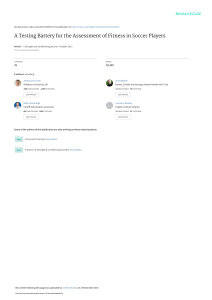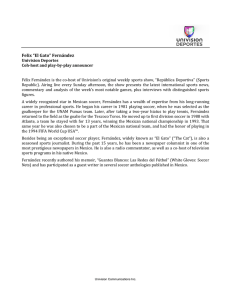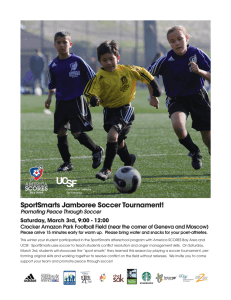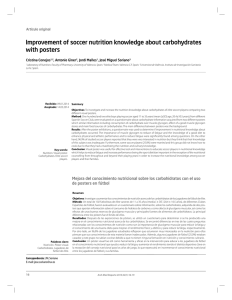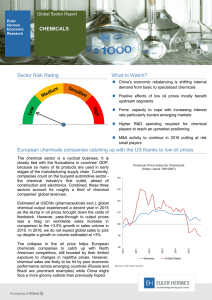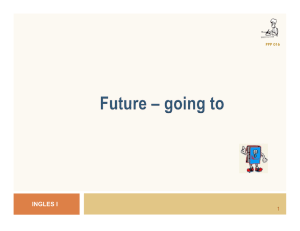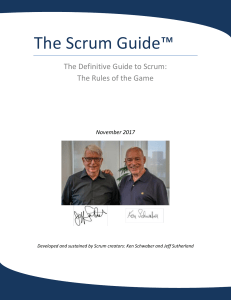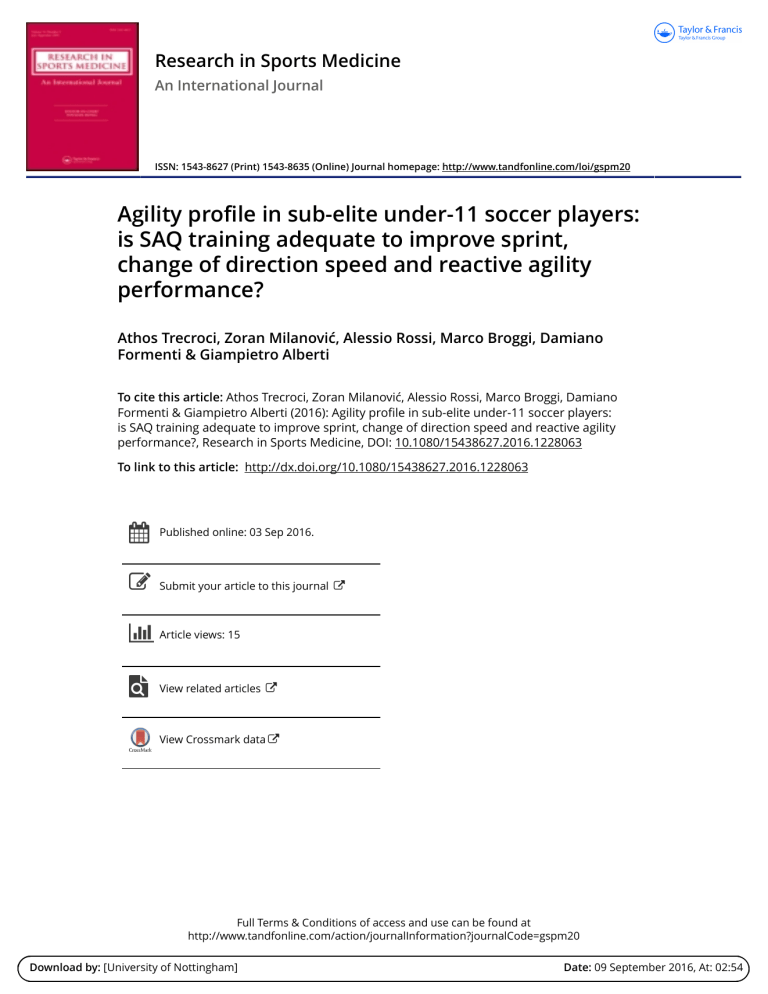
Research in Sports Medicine An International Journal ISSN: 1543-8627 (Print) 1543-8635 (Online) Journal homepage: http://www.tandfonline.com/loi/gspm20 Agility profile in sub-elite under-11 soccer players: is SAQ training adequate to improve sprint, change of direction speed and reactive agility performance? Athos Trecroci, Zoran Milanović, Alessio Rossi, Marco Broggi, Damiano Formenti & Giampietro Alberti To cite this article: Athos Trecroci, Zoran Milanović, Alessio Rossi, Marco Broggi, Damiano Formenti & Giampietro Alberti (2016): Agility profile in sub-elite under-11 soccer players: is SAQ training adequate to improve sprint, change of direction speed and reactive agility performance?, Research in Sports Medicine, DOI: 10.1080/15438627.2016.1228063 To link to this article: http://dx.doi.org/10.1080/15438627.2016.1228063 Published online: 03 Sep 2016. Submit your article to this journal Article views: 15 View related articles View Crossmark data Full Terms & Conditions of access and use can be found at http://www.tandfonline.com/action/journalInformation?journalCode=gspm20 Download by: [University of Nottingham] Date: 09 September 2016, At: 02:54 RESEARCH IN SPORTS MEDICINE, 2016 http://dx.doi.org/10.1080/15438627.2016.1228063 Agility profile in sub-elite under-11 soccer players: is SAQ training adequate to improve sprint, change of direction speed and reactive agility performance? Athos Trecrocia, Zoran Milanovićb, Alessio Rossia, Marco Broggia, Damiano Formentia and Giampietro Albertia a Department of Biomedical Sciences for Health, Università degli Studi di Milano, Milan, Italy; bFaculty of Sport and Physical Education, University of Nis, Nis, Serbia ABSTRACT ARTICLE HISTORY The purpose of this study was to examine the effects of speed, agility and quickness (SAQ) training on acceleration (5 and 20 m), change of direction speed (CODS) and reactive agility in preadolescent soccer players. Thirty-five participants (age = 10.57 ± 0.26, body mass = 36.78 ± 5.34 kg, body height = 1.42 ± 0.05 m), randomly assigned to experimental (EG, n = 20) and control groups (CG, n = 15), completed a 12-week training intervention, 2 day/week. A significant interaction was found in 5-m sprint (P < 0.05, part η2 = 0.117) and reactive agility (P < 0.01, part η2 = 0.248) between EG and CG. In both groups, 20-m sprint time improved significantly (P < 0.05, effect size = 0.3–0.4) while performance on CODS remained unchanged after 12 weeks. These findings indicated that SAQ training could positively affect cognitive skills and initial sprint acceleration through the middle childhood, offering useful guidance to soccer coaches. Received 27 March 2016 Accepted 14 August 2016 KEYWORDS Athletic performance; complex training; physical activity; planning; youth Introduction Speed, agility and quickness (SAQ) are important determinants of the soccer anaerobic fitness that allow players to address successfully crucial moments (e.g. winning ball possession, dribbling an opponent and/or scoring a goal) throughout the match (Hammami, Makhlouf, Chtara, Padulo, & Chaouachi, 2015). However, these determinants are characterized by diverse physiological and biomechanical factors (Little & Williams, 2005) and their individual training would produce limited transfer to each other (Young, McDowell, & Scarlett, 2001). Since soccer performance depends on multidimensional physical demands (Bangsbo, Mohr, & Krustrup, 2006) based on open (e.g. reaction tasks) and closed skill activities (e.g. change of direction speed [CODS]) (Gabbett, Sheppard, Pritchard-Peschek, Leveritt, & Aldred, 2008; Ibba et al., 2014; Padulo et al., 2014, 2015, 2015; Trecroci, Cavaggioni, Caccia, & Alberti, 2015), it would be conceivable using training methods aimed to promote integrated effects of SAQ at improving CONTACT Athos Trecroci [email protected] Department of Biomedical Sciences for Health, Università degli Studi di Milano, Via G. Colombo, 71, 20133 Milan, Italy © 2016 Informa UK Limited, trading as Taylor & Francis Group 2 A. TRECROCI ET AL. physiological and biomechanical adaptations, thus, saving energy and time (Jovanovic, Sporis, Omrcen, & Fiorentini, 2011). In this context, the SAQ training method refers to a training approach combining high rate of movement tasks performed in a brief amount of time (quickness) and both straight (speed) and multidirectional sprints over different distances with and without cognitive stimuli (agility) that has become popular within soccer-related literature (Bloomfield, Polman, O’Donoghue, & McNaughton, 2007; Jovanovic et al., 2011; Milanović, Sporiš, Trajković, James, & Šamija, 2013; Milanović et al., 2014; Polman, Walsh, Bloomfield, & Nesti, 2004). Previous studies showed significant improvements in the 5- and 10-m sprint tests, reporting that SAQ training was an effective tool for improving sprint performance up to 10 m (Jovanovic et al., 2011; Milanović et al., 2014). In addition, after a 12-week SAQ training programme, Milanović et al. (2013) observed a significant enhancement in the CODS with and without ball among under-19 soccer players. A further study investigated the effects of different SAQ training approaches on elite female athletes (Polman et al., 2004). Polman et al. (2004) have showed that SAQ training using either specialized (e.g. speed-ladder, hurdles, reaction balls and resistance cords) or non-specialized equipment (e.g. traditional soccer coaching equipment) produced similar effects after 12-week training programme. The two approaches led to greater improvements in sprint, CODS performance and vertical and horizontal jump tasks compared to regular soccer-specific training. They concluded that SAQ training seemed to be an appropriate physical conditioning element for young adult female soccer players. Despite well-established advantages of using an integration of SAQ activities in young adults and adolescents, to date, no studies have been conducted on younger athletes. Preadolescent soccer players experience various exercises similar to those incorporated in the SAQ method within their regular training sessions. For example, during the sampling stage (from age 6 to 12 years), young athletes engage with both deliberate and non-deliberate practice (e.g. age-adapted game formats and technical drills) that contain rapid multi-directional steps, accelerations, decelerations, turnings, as well as cognitive stimuli provided by unpredictable actions of soccer-related games (Trecroci et al., 2015). According to Fransen et al. (2012), sampling stage is considered beneficial for athletic and perceptual development in young athletes. Thus, training methods including a combination of physical and cognitive drills (i.e. SAQ training) may be more effective for middle childhood than adulthood (Fransen et al., 2012). Therefore, the aim of this study was to investigate the effectiveness of a 12-week SAQ training programme on acceleration, CODS and reactive agility profile in sub-elite under11 soccer players. We hypothesized that training based on SAQ would be more effective than a mere sport-specific training for improving acceleration, CODS and reactive agility in preadolescent soccer players. Materials and methods Participants Thirty-nine sub-elite young soccer players were recruited for the study and randomly divided in two groups using a random allocation table by means of which it was RESEARCH IN SPORTS MEDICINE 3 generated an unpredictable random sequence for assigning participants to experimental (EG) and control groups (CG). Twenty players were allocated in the EG (age: 10.5 ± 0.30 years; body mass: 37.94 ± 6.00 kg; height: 1.42 ± 0.05 m; body mass index [BMI]: 18.05 ± 2.11 kg/m2; maturity offset: −2.58 ± 0.15; soccer training experience: 3.50 ± 0.66 years), while 19 players were allocated in the CG (age: 10.7 ± 0.21 years; body mass: 35.24 ± 3.98 kg; height: 1.42 ± 0.06 m; BMI: 16.86 ± 1.30 kg/m−2; maturity offset: −2.48 ± 0.10; soccer training experience: 3.41 ± 0.55 years). Unfortunately, four participants of the CG dropped out prior to conclude the study for external reasons. All players and their parents were informed about the purpose and experimental protocol of the study. Parents or legal guardians provided the written informed consent before the investigation. In accordance with the Declaration of Helsinki, the study was approved by the ethics committee of the local University. Procedures All participants underwent a 4-week (two sessions per week) familiarization period before starting the training intervention (Figure 1). Anthropometric characteristics including height and weight were measured using a stadiometer (SECA 213, Germany) and a portable scale (SECA 813, Germany) to the nearest 1.0 cm and 0.1 kg 48 h prior to testing; with this data, we also calculated the BMI and the maturation index of the players. This index was calculated by the following redeveloped equation of Moore et al. (2015): maturity offset = −7.999994 + (0.0036124 × [age × height]) with R2 = 0.896, and the standard error of estimated = 0.542. Within testing session, 5- and 20-m sprint tests were selected to assess first-steps acceleration and speed characteristics of each participant. While, modified Illinois change of direction and reactive agility tests were included to detect participant’s ability to change direction under several pattern of movements as well as to react to visual stimuli provided by a live opponent. To evaluate test–retest reliability, all participants were tested on an artificial turf wearing soccer shoes in two separated days with at least 48 h in between. All tests were randomly performed at the same time of day (from 5 to 7 p.m.) for pre- and post-test sessions. A 5min warm-up period consisting of general running exercises (e.g. jogging forwards and backwards) and dynamic stretching (e.g. “knee to chest” and “high kicks” exercises) preceded each test, while 10-min of rest was given among tests. A photocells timing Figure 1. The training programme design. 4 A. TRECROCI ET AL. system (Polifemo Radio, 0.125-ms resolution, Microgate, Bolzano, Italy) was used to record split completion times, and the timing gates were placed at 0.70 m above the ground. Fastest trial for each turn was included in the analysis. Trials for 5- and 20-m sprint tests On command, participants performed three trials of 20-m sprint (0–5, 0–20 m intervals) starting from a standing position. To prevent fatigue-induced effects, a recovery of 3 min was given among trials. Modified Illinois change of direction test (MICODT) A MICODT was used to assess CODS profile among different patterns of movement including sprints, directional changes, turnings and slalom runs (Hachana et al., 2014). On command, from a standing position, participants ran from point A to point B as shown in Figure 2(a). They performed three trials resting 3 min in-between. Participants were also instructed not to cut over the cones but to move around without touching or hitting them. In case of failure, the trial was repeated after an extra recovery (~1 min). Reactive agility test (RAT) The RAT used in this study referred to the similar Y-shaped agility test previously adopted by other authors (Green, Blake, & Caulfield, 2011; Oliver & Meyers, 2009; Veale, Pearce, & Carlson, 2010) and including a live experimenter. After an initial sprint, participants were required to react to the left or to the right gates according to the experimenter’s movements: (i) step forward with the right or left foot, and change direction to the left or right, respectively; (ii) step forward with the right or left, then left or right, and change direction to the right or left, respectively. All participants were Figure 2. (a) Layout of the Modified Illinois Change of Direction Test (MICODT); (b) Schematic representation of the reactive agility test (RAT) with the addition of a live experimenter. RESEARCH IN SPORTS MEDICINE 5 asked not to anticipate the reaction [Figure 2(b)]. Four trials were executed in a randomized order with 2 min of rest in-between. Training intervention The intervention programmes involved 12-weeks in-season period from the beginning of March until the end of May consisting in 24 training sessions, 2 days/week separated by at least 48 h. Each intervention lasted 25 min, and it was given at the beginning of the training session after an 8-min warm up with slow running and dynamic stretching (Chaouachi et al., 2015). The SAQ-training programme consisted of brief efforts (from 3 to 5 s) in the form of SAQ drills (Table 1) arranged in two phases interspersed by 5 min of rest. Both phases lasted 10 min and matched for number of drills, work volume/drill and rest between drills (Table 2). Each experimental training session was organized in four stations for every single drill with an equal number of participants (five per group) to maintain the intensity as high as possible (Dawes, Roozen, & National Strength & Conditioning Association, 2012). Participants commenced each station one after the other with an approximately work:rest ratio of 1:2 during a single repetition. A supervisor with years of experience in strength and conditioning coaching monitored the entire execution, providing verbal encouragement and technical support. The CG performed soccer-specific drills also arranged in two phases for the same amount of time of the EG (i.e. 25 min). The first phase included high-intensity technical circuits (e.g. relay race including ball carrying, passing, heading, and dribbling drills) while the second phase included progressive evasion drills with a combination of defensive and offensive maneuvers (1 on 1, 2 on 1, 2 on 2 and 3 on 2) over the 12 Table 1. Descriptive characteristics of the 12-week SAQ training intervention performed by the EG. SAQ intervention Weeks Week 1 and 2 Week 3–5 Week 6–8 Week 9–12 First phase Second phase Quickness and agility Foot-working exercises using hoops (e.g. split steps, line drills, lateral line hops and multiple hops) Speed-ladder exercises with a combination of basic drills (e.g. one/two in the hole, skipping and hopscotch) Speed-ladder exercises with a combination of advanced drills (e.g. carioca, cha-cha, cherry pickers and slaloms) Speed-ladder exercises in combination with agility drills (e.g. reaction to a visual stimulus) Speed, CODS and agility Brief sprints with few directional changes (e.g. from 1 to 3) and different angles (30° and 45°) Brief sprints with several directional changes (e.g. from 3 to 5) and different angles (30°, 45° and 90°) Agility drills in response to different commands (e.g. colour tag, right-to-left direction) Agility drills with an opponent (e.g. chasing runs, “mirror” drills) SAQ: speed, agility and quickness, CODS: change of direction speed. Table 2. Framework of a single SAQ training session. SAQ programme SAQ training session No. of drills Work volume/ drill (s) Rest between drills/ exercise (s) Single phase duration (min) Rest between phases (min) First phase Second phase 4 4 120 120 30 40 10 10 5 SAQ: speed, agility and quickness. 6 A. TRECROCI ET AL. weeks, two sessions per week. As for the SAQ session, all exercises were conducted with a work:rest ratio of 1:2 during each repetition. Statistical analyses Test–retest reliability was assessed for 5- and 20-m sprint tests, MICODT and RAT using a one-way intra-class correlation coefficient (ICC) based on average measurements (ICC 1, k). According to the normality assessed by Shapiro-Wilks’ test, unpaired t-tests were used to detect difference between EG and CG in anthropometric characteristics and in pretraining test evaluations. Changes in sprint, CODS and reactive agility of both groups were analysed using a two-way analysis of variance (ANOVA) repeated measures on one factor (e.g. time). Effect size (ES) was calculated for multiple comparisons to determine the magnitude of the pre–post changes. ES were classified as follows: <0.2 was defined as trivial, 0.2–0.6 was defined as small, 0.6–1.2 was defined as moderate, 1.2–2.0 was defined as large, and >2.0 was defined as very large (Hopkins, Marshall, Batterham, & Hanin, 2009). The level of significance was set at P < 0.05, and data were shown as mean ± SD. Statistical analysis was performed using SPSS 21.0 for windows (IBM SPSS Statistics, Inc., New York, NY, USA). Results Both EG and CG presented non-significant differences for age, anthropometric characteristics and overall performance variables at the pre-training (P > 0.05). A good level of test–retest reliability was attained for 5- and 20-m sprint tests (ICC = 0.88, ICC = 0.92), and for MICODT and RAT (ICC = 0.88, ICC = 0.85), respectively. Significant interactions were found in 5-m sprint test (F1,33 = 4.738, P = 0.044, part η2 = 0.117) and RAT (F1,33 = 10.889, P = 0.002, part η2 = 0.248). The EG, compared to the CG, obtained greater pre–post changes in both tests as showed by the ES (Table 3). A within-subjects difference was observed in the 20-m sprint test (F1,33 = 11.372, P = 0.002, part η2 = 0.256) in both groups (Table 3). The CODS measured by MICODT remained unchanged for both EG and CG after the intervention (F1,33 = 1.399, P = 0.245, part η2 = 0.041). Table 3. Differences in sprint, change of direction speed and reactive agility after 12-week training programme (mean ± SD). EG (N = 20) 5-m sprint test (s)* 20-m sprint test (s)ǂ MICODT (s) RAT (s)* Pre 1.53 ± 0.08 4.27 ± 0.24 13.35 ± 0.66 2.85 ± 0.15 Post 1.50 ± 0.08 4.16 ± 0.26 13.4 ± 0.52 2.73 ± 0.15 CG (N = 15) (%) 2.0 2.6 0.4 4.2 ES 0.4 0.4 0.0 0.8 Pre 1.49 ± 0.07 4.11± 0.22 13.10 ± 0.69 2.78 ± 0.19 Post 1.50 ± 0.09 4.05 ± 0.23 13.08 ± 0.68 2.75 ± 0.19 (%) 0.7 1.5 0.2 1.1 ES 0.1 0.3 0.0 0.2 Interaction: *P < 0.05; within-subjects factor: ǂP < 0.05. MICODT: Modified Illinois Change of Direction Test, RAT: reactive agility test, ES: effect size, EG: experimental groups, CG: control group, % = per cent change in performance. RESEARCH IN SPORTS MEDICINE 7 Discussion The main findings of this study indicated that a 12-week SAQ training programme improved significantly 5-m sprint and RAT performance in preadolescent soccer players compared to a mere soccer training. The ability to perform maximal running tasks over short distances is considered an essential component of the running performance during matches (Dawes et al., 2012; Tomáš, František, Lucia, & Jaroslav, 2014). The significant improvement observed on 5-m sprint may be attributed to the specificity of foot-working exercises (e.g. split steps, skipping and multiple hops) conducted by the EG, which were based on short contact times with the surface. This condition can elicit to higher forces production at faster rates, resulting in an increase in power (Bloomfield et al., 2007). It has been shown that 10–11-year-old children may be largely benefited by explosive activities (based on rapid stretch-shortening cycle) improving their sprint time because of high neuromuscular adaptations (e.g. intra- and intramuscular coordination) (Michailidis et al., 2013). Similar improvements were also reported on sprint performance up to 15 m in other studies in adolescent and young adult athletes, supporting the use of SAQ method for enhancing acceleration in soccer (Bloomfield et al., 2007; Jovanovic et al., 2011; Milanović et al., 2014). Hence, in this study, it can be speculated that 5-m sprint improvements could be due to a gain in stretch-shortening cycle ability via improved intra- and intermuscular coordination in the first steps (Trecroci et al., 2015). In light of this, the present result might have implication throughout a match by increasing the chance of players to win one-on-one duels, or successfully defending an attack. To the best of the author’s knowledge, this is the first study assessing the effects of SAQ training on reactive agility in preadolescent soccer players. Addressing decision-making demands during the sampling stage becomes crucial to youth athletic development at improving reaction skills. The present results showed a moderate effect on the total time of the RAT performance in the EG (P < 0.05). This finding may be likely due to the integrated effects provided by agility drills in response to an opponent (e.g. chasing runs) and different commands (e.g. right-to-left directions) based on non-sport specific stimuli. Accordingly, a recent large-sampled study on 553 subjects has monitored reaction time along age in response to non-task specific stimuli (Zemková & Hamar, 2014). The participants had to touch four mats located at the corners of a 0.55-m square according to visual stimuli (rear right or left and front right or left) generated by a computer screen. Zemková and Hamar (2014) observed greater improvements, from ages 7 to 14 compared to older, in which the size of such positive trend appeared smaller along age. As a result, the authors stated that reaction skills based on general perceptual components would be effectively trainable in the middle childhood. The latter consideration seems to be consistent with the results found in the CG. At the end of the 12-week intervention, RAT improvements of the CG were negligible (P > 0.05) with a small estimated ES. It is reasonable thinking that the little soccer training background of the participants (<4 years) may have limited positive transfer of highly sportspecific stimuli by evasive drills performed in the study. The ability to rapidly decelerate, change body direction and accelerate in a planned context (e.g. CODS) is an important prerequisite in the soccer-related tasks that has to be trained as well as monitored throughout a season (Young & Rogers, 2014). After 12 weeks of training, however, CODS profile measured by MICODT remained unchanged in 8 A. TRECROCI ET AL. both groups. A plausible explanation can be given by the fact that CODS trainability is associated with the prepubertal spurt, achieving its peak rate of development approximately at 13–14 years of age (Lloyd et al., 2013). Thus, potential neuromuscular adaptations derived from SAQ training may not have been adequate enough to affect CODS performance in under-11 soccer players of this study. This seems to support the fact that focusing on CODS development in the prepubescent may not be a primary aim of youth training programmes as reported previously (Lloyd et al., 2013). With regard to the speed assessment, both EG and CG exhibited a significant improvement in the 20-m sprint time with a small effect (0.2 < ES < 0.6) after 12 weeks. This result is in contrast with those reported in literature for older athletes in which no performance gains were observed on 20-m sprint after SAQ training (Jovanovic et al., 2011; Milanović et al., 2014). In fact, these authors observed that increases in sprint performance via SAQ method were effective solely over short distances (i.e. 0–5 m) because of the specificity of movement patterns over short distance. However, as the present ES were small for both groups, it is conceivable that performance gains observed on 20-m sprint were due to other factors rather than a training effect. In fact, concurrent small ES detected in both groups may be likely the result from a natural nervous system development, which is known to be dominant within the sampling years (Ostojic et al., 2014). As far as the authors are concerned, this study presents a limitation that has to be considered. In the RAT, the total time was the only variable taken into account to evaluate participants’ response rather than decision time. In fact, although both time variables are correlated (Young & Willey, 2010), one may argue that positive effects in the RAT would be the result of an improvement in the 5-m sprint rather than in decisionmaking factors. However, if that were true, we would have also expected an improvement in the MICODT. Nonetheless, further studies should be encouraged to introduce high-speed video recordings to identify all of the time variables affecting reactive agility performance in the attempt to corroborate or not our results. Conclusions SAQ training method appeared to be more effective at improving acceleration over 5 m and reactive agility than a soccer-specific training programme in preadolescent soccer players. From a practical point of view, our novel findings indicated that the agility profile can be successfully improved in the middle childhood through organized SAQ drills. On the contrary, SAQ training seemed not be adequate for enhancing speed and CODS performance in the same period. Acknowledgement The authors would like to thank Luca Rimoldi (M.Sc.) for his technical support. Disclosure statement No potential conflict of interest was reported by the authors. RESEARCH IN SPORTS MEDICINE 9 References Bangsbo, J., Mohr, M., & Krustrup, P. (2006). Physical and metabolic demands of training and match-play in the elite football player. Journal of Sports Sciences, 24(7), 665–674. doi:10.1080/ 02640410500482529 Bloomfield, J., Polman, R., O’Donoghue, P., & McNaughton, L. (2007). Effective speed and agility conditioning methodology for random intermittent dynamic type sports. The Journal of Strength and Conditioning Research, 21(4), 1093. doi:10.1519/R-20015.1 Chaouachi, A., Padulo, J., Kasmi, S., Othmen, A. B., Chatra, M., & Behm, D. G. (2015). Unilateral static and dynamic hamstrings stretching increases contralateral hip flexion range of motion. Clinical Physiology and Functional Imaging, 2015. doi:10.1111/cpf.12263 Dawes, J., Roozen, M., & National Strength & Conditioning Association. (2012). Developing agility and quickness. Champaign, IL: Human Kinetics. Fransen, J., Pion, J., Vandendriessche, J., Vandorpe, B., Vaeyens, R., Lenoir, M., & Philippaerts, R. M. (2012). Differences in physical fitness and gross motor coordination in boys aged 6–12 years specializing in one versus sampling more than one sport. Journal of Sports Sciences, 30(4), 379– 386. doi:10.1080/02640414.2011.642808 Gabbett, T. J., Sheppard, J. M., Pritchard-Peschek, K. R., Leveritt, M. D., & Aldred, M. J. (2008). Influence of closed skill and open skill warm-ups on the performance of speed, change of direction speed, vertical jump, and reactive agility in team sport athletes. The Journal of Strength & Conditioning Research, 22(5), 1413–1415. doi:10.1519/JSC.0b013e3181739ecd Green, B. S., Blake, C., & Caulfield, B. M. (2011). A valid field test protocol of linear speed and agility in rugby union. The Journal of Strength & Conditioning Research, 25(5), 1256–1262. doi:10.1519/ JSC.0b013e3181d8598b Hachana, Y., Chaabène, H., Ben Rajeb, G., Khlifa, R., Aouadi, R., Chamari, K., & Gabbett, T. J. (2014). Validity and reliability of new agility test among elite and subelite under 14-soccer players. PLoS ONE, 9(4), e95773. doi:10.1371/journal.pone.0095773 Hammami, R., Makhlouf, I., Chtara, M., Padulo, J., & Chaouachi, A. (2015). The contribution of vertical explosive strength to sprint performance in children. Sport Sciences for Health, 11, 37–42. doi:10.1007/s11332-014-0200-2 Hopkins, W. G., Marshall, S. W., Batterham, A. M., & Hanin, J. (2009). Progressive statistics for studies in sports medicine and exercise science. Medicine & Science in Sports & Exercise, 41(1), 3–13. doi:10.1249/MSS.0b013e31818cb278 Ibba, G., Pizzolato, F., Di Michele, R., Scorcu, M., Attene, G., Paradisis, G., . . . Padulo, J. (2014). Uphill sprint vs. intermittent running in young soccer players: Acute physiological responses. Sport Sciences for Health, 10, 61–66. doi:10.1007/s11332-014-0174-0 Jovanovic, M., Sporis, G., Omrcen, D., & Fiorentini, F. (2011). Effects of speed, agility, quickness training method on power performance in elite soccer players. The Journal of Strength & Conditioning Research, 25(5), 1285–1292. doi:10.1519/JSC.0b013e3181d67c65 Little, T., & Williams, A. G. (2005). Specificity of acceleration, maximum speed, and agility in professional soccer players. Journal of Strength and Conditioning Research, 19(1), 76–78. doi:10.1519/14253.1 Lloyd, R. S., Read, P., Oliver, J. L., Meyers, R. W., Nimphius, S., & Jeffreys, I. (2013). Considerations for the development of agility during childhood and adolescence. Strength & Conditioning Journal, 35(3), 2–11. doi:10.1519/SSC.0b013e31827ab08c Michailidis, Y., Ioannis, G. F., Primpa, E., Michailidis, C., Avloniti, A., Chatzinikolaou, A., . . . Kambas, A. (2013). Plyometrics’ trainability in preadolescent soccer athletes. Journal of Strength and Conditioning Research, 27(1), 38–49. doi:10.1519/JSC.0b013e3182541ec6 Milanović, Z., Sporiš, G., Trajković, N., James, N., & Šamija, K. (2013). Effects of a 12 week saq training programme on agility with and without the ball among young soccer players. Journal of Sports Science & Medicine, 12(1), 97. Retrieved from http://www.ncbi.nlm.nih.gov/pmc/arti cles/PMC3761749/ 10 A. TRECROCI ET AL. Milanović, Z., Sporiš, G., Trajković, N., Sekulić, D., James, N., & Vučković, G. (2014). Does SAQ training improve the speed and flexibility of young soccer players? A randomized controlled trial. Human Movement Science, 38, 197–208. doi:10.1016/j.humov.2014.09.005 Moore, S. A., McKay, H. A., Macdonald, H., Nettlefold, L., BaxterJones, A. D., Cameron, N., & Brasher, P. M. (2015). Enhancing a somatic maturity prediction model. Medicine and Science in Sports and Exercise, 47, 1755–1764. doi:10.1249/MSS.0000000000000588 Oliver, J. L., & Meyers, R. W. (2009). Reliability and generality of measures of acceleration, planned agility, and reactive agility. International Journal of Sports Physiology and Performance, 4(3), 345– 354. Retrieved from http://journals.humankinetics.com Ostojic, S. M., Castagna, C., Calleja-González, J., Jukic, I., Idrizovic, K., & Stojanovic, M. (2014). The biological age of 14-year-old boys and success in adult soccer: Do early maturers predominate in the top-level game? Research in Sports Medicine, 22(4), 398–407. doi:10.1080/ 15438627.2014.944303 Padulo, J., Di Giminiani, R., Ibba, G., Zarrouk, N., Moalla, W., Attene, G., . . . Chamari, K. (2014). The acute effect of whole body vibration on repeated shuttle-running in young soccer players. International Journal of Sports Medicine, 35(1), 49–54. doi:10.1055/s-0033-1345171 Padulo, J., Tabben, M., Ardigo, L. P., Ionel, M., Popa, C., Gevat, C., . . . Dello, I. A. (2015). Repeated sprint ability related to recovery time in young soccer players. Research in Sports Medicine, 23(4), 412–423. doi:10.1080/15438627.2015.1076419 Padulo, J., Tabben, M., Attene, G., Ardigo, L. P., Dhahbi, W., & Chamari, K. (2015). The impact of jumping during recovery on repeated sprint ability in young soccer players. Research in Sports Medicine, 23(3), 240–252. doi:10.1080/15438627.2015.1040919 Polman, R., Walsh, D., Bloomfield, J., & Nesti, M. (2004). Effective conditioning of female soccer players. Journal of Sports Sciences, 22(2), 191–203. doi:10.1080/02640410310001641458 Tomáš, M., František, Z., Lucia, M., & Jaroslav, T. (2014). Profile, correlation and structure of speed in youth elite soccer players. Journal of Human Kinetics, 40(1). doi:10.2478/hukin-2014-0017 Trecroci, A., Cavaggioni, L., Caccia, R., & Alberti, G. (2015). Jump rope training: Balance and motor coordination in preadolescent soccer players. Journal of Sports Science and Medicine. 14, 792– 798. Retrieved from http://www.jssm.org/gecjssm-14-792.xml.xml Veale, J. P., Pearce, A. J., & Carlson, J. S. (2010). Reliability and validity of a reactive agility test for Australian football. International Journal of Sports Physiology and Performance, 5(2), 239–248. Retrieved from http://journals.humankinetics.com/ijspp-back-issues/ijspp-volume-6-issue-4december Young, W., & Rogers, N. (2014). Effects of small-sided game and change-of-direction training on reactive agility and change-of-direction speed. Journal of Sports Sciences, 32(4), 307–314. doi:10.1080/02640414.2013.823230 Young, W. B., McDowell, M. H., & Scarlett, B. J. (2001). Specificity of sprint and agility training methods. The Journal of Strength and Conditioning Research, 15(3), 315. doi:10.1519/1533-4287 (2001)015<0315:SOSAAT>2.0.CO;2 Young, W. B., & Willey, B. (2010). Analysis of a reactive agility field test. Journal of Science and Medicine in Sport, 13(3), 376–378. doi:10.1016/j.jsams.2009.05.006 Zemková, E., & Hamar, D. (2014). Age-related changes in agility time in children and adolescents. International Journal of Science and Research, 3(11), 280–285. Retrieved from http://www.ijsr.net/ archive/v3i11/T0NUMTQ3NjY=.pdf
